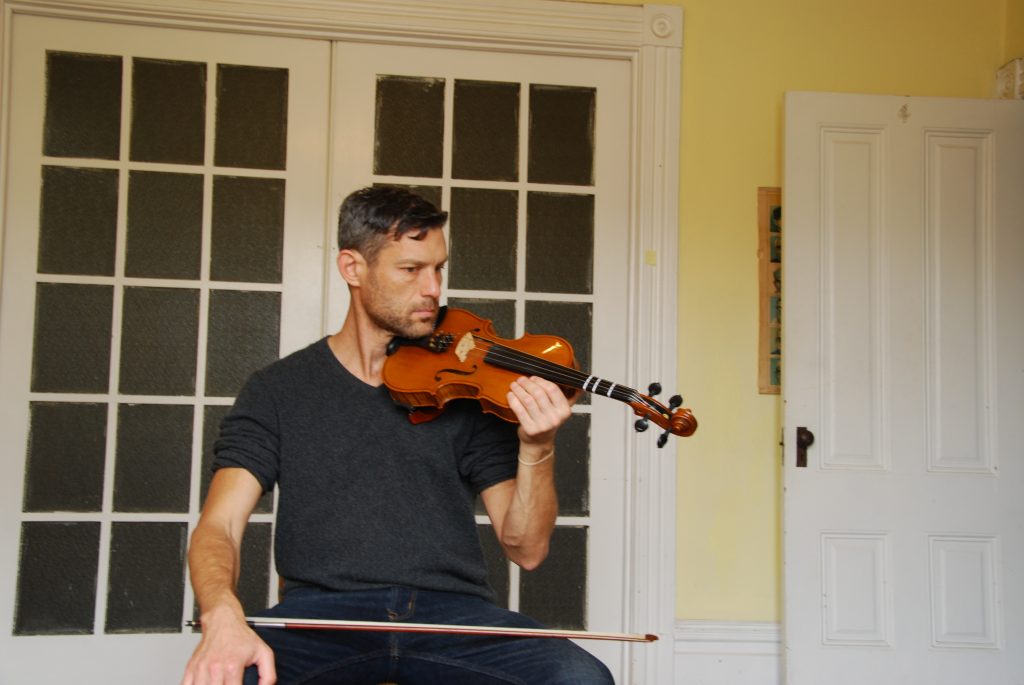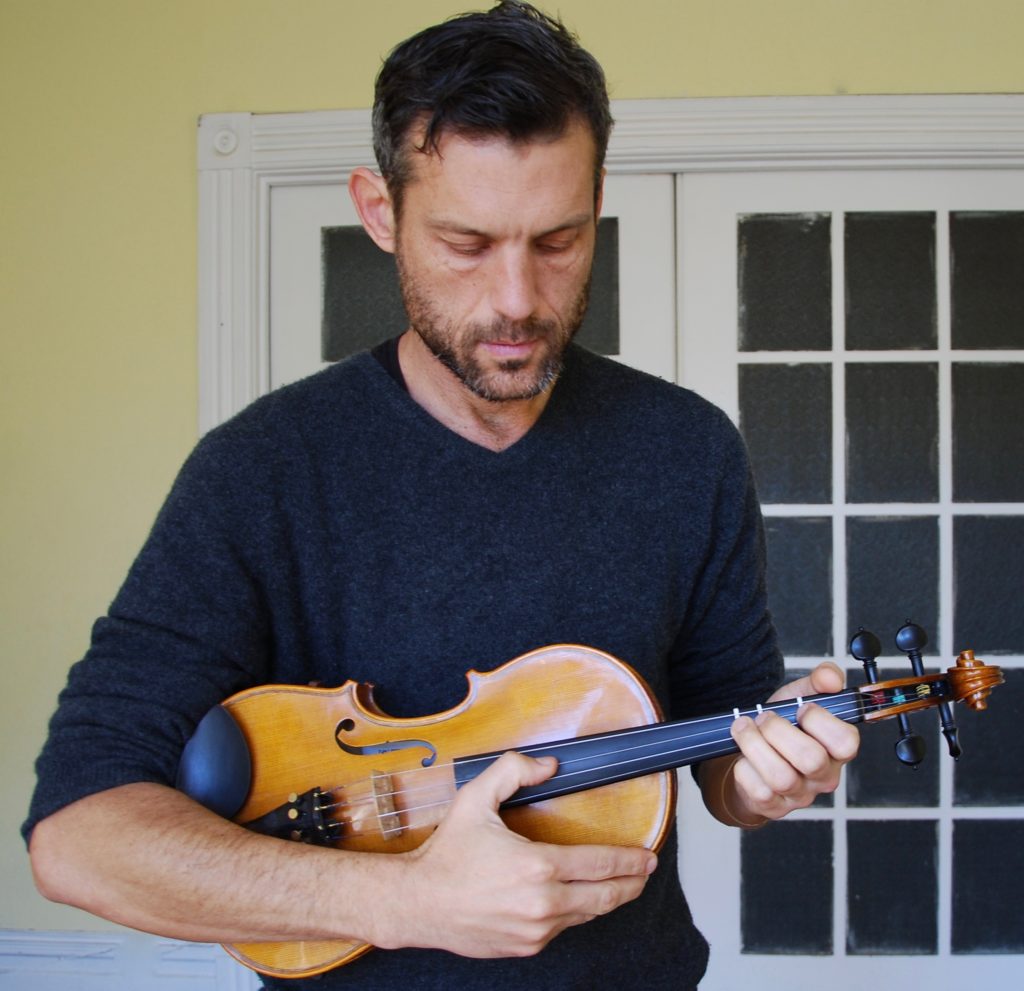How To Hold The Violin
Discovering the Right Way to Hold a Violin
If you learn the correct way to hold the violin, then you’ll sound better. And a good sound means you’ll enjoy the process and be more motivated to continue.
Plus, with a solid hold, you’ll be less likely to injure yourself. Don’t forget to be kind to your body!
I’ll show you four useful ways to hold the violin:
- Guitar Hold
- Beginner Hold
- Classical Hold
- Old-time Fiddle Hold
Though the Classical hold is the most common (and the most versatile) the other holds have their uses.
Hold The Violin In Guitar Position
Hold the violin like a guitar and experiment with plucking the strings using your right thumb.
This position, though primarily used for learning and practice, can be a great tool to decode tricky rhythms, fingerings, and melodies. Once you’ve mastered a melody in guitar position, you can transition to the more challenging classical hold.
Another advantage of Guitar Position is that it’s a great way to practice violin chords. I’ll talk about playing chord back-up later in the guide.
Embracing the Beginner’s Violin Hold

Now let’s learn the beginner hold.
Position your violin between your chin and left shoulder, resting your left hand on the body instead of the fingerboard. Place your chin on the chin rest and use it to clamp down on the violin. You may need to experiment with different chin rests. For example, you can get a center mount chin rest:

It’s important for the body to be comfortable. Playing violin is not about suffering through physical pain!
This simplified hold allows you to focus on the right-hand movements of plucking and bowing. Even as an advanced player, the beginner’s hold can be a useful tool to refine your bowing and rhythm skills.
Mastering the Classical Violin Hold
For a more versatile violin playing experience covering all genres, from classical to jazz, the classical hold is your go-to posture. Much like the beginner’s hold, you hold the violin by clamping your chin down on the chin rest.
The difference lies in the left-hand placement, which is at the neck’s end, just below the scroll. Spend time just getting comfortable with this posture before attempting to play notes. Regularly practicing this hold even after you’ve started playing songs will significantly improve your skills.
Remember that a shoulder rest makes it easier to hold the violin without relying on the left hand to hold it.
Experimenting with the Old-Time Fiddle Hold

For this hold, simply let the violin rest against your shoulder.
This method offers more comfort and ease while singing and playing simultaneously. However, it limits you to playing in the first position. It makes it harder to shift your left-hand up the neck to play notes and higher positions.
If you see yourself playing a variety of music styles, the classical hold is recommended. It offers more versatility, allowing you to play old-time and other fiddle music effortlessly. But if you know you just want to play Old-time and Appalachian music, then the Old-Time Hold may be right for you.
How To Put On A Shoulder Rest

Holding the violin can strain the neck and back. For that reason, a lot of fiddlers use a shoulder rest. This fits on the back of the violin near the bottom. Most people place it close the bottom. I like to place it closer to the middle.
Not only does it feel more relaxed, but the violin makes contact with my collar bone. Because of that, I can actually feel the vibration of the instrument directly in my body.
If you have a secure hold, see if you can hold the violin without using your right hand. Eventually, you can learn to make a sandwich while holding the fiddle:
Now that you know how to hold the violin, you’re finally ready to make some sounds!
Another video on holding the violin…
Continue on to Plucked Up >>
Return to top of Module 1.1 >>
Leave a Reply
You must be logged in to post a comment.



It’s really frustrating that you don’t show how to tune the fiddle before you ask the player to make notes and sounds. Yikes. I had to skip around the videos to find the tuning one.
Hi Daniel, really appreciate your feedback on this. That makes sense. We will work on improving this, thank You!
gratitude for the basics!
Love your perspective, Annie!
…. this is fun.
Great you enjoy this, Alvin. Thanks for fiddling with us 🎻
Why am I unauthorized to go on to continue on to plucked up?
Hi Jerry, thanks for asking. I will email you shortly to continue this discussion 🙂
I can’t believe I’m doing my first lesson after waiting to start for soooooo long. A-mazing. Really appreciate how slow and deliberate your lessons are. After plucking and trying different holds, I am not terrified of holding the violin. Less afraid is good! The sandwhich was a hoot. Thanks for your encouragement and clear explanations. Excited to be making nice sounds!
Way to be, Claudia, thanks for this reflection. So great you resonate well with the program! 🥳 🎶
Not only did you make a sandwich, you also made a salad too!
Too funny
I just ordered a shoulder rest. 😉
So good 🙂 Awesome Cathleen, enjoy!
I am starting again, and again I am getting pain in my neck and shoulder. What am I doing wrong?
Thank you!
Jo
Hi Jo, Thanks for mentioning this and inquiring. It can help greatly to have a professional violinist/luthier/teacher help, in person, fit your instrument to your natural posture. They can see from a different angle what kind of shoulder rest is needed and how to position it.
I use a shoulder rest that is recommended on the Fiddle gear page, called Bon Musica. I’ve found it to be very versatile in fitting the violin to my posture/body and helping secure the violin while playing. https://fiddlehed.com/contact-help-new/recommended-gear-books-and-music/
Be interesting to hear how that journey evolves for you. Pain and uncomfortability doesn’t need to be a regular part of playing fiddle. Reach out anytime 🙂
nice steady way of learning, loving it
Thanks for sharing your experience, Peter 💗
Loving your teaching
Great to hear this, Joe
My dad held it like a cello. Not what he was taught, but did it to annoy his 3 violin playing sisters. Thanks for the videos including the sandwich making one. 😉
Thanks for sharing this! Indeed the humour carries with us well 🙂
Great teaching method have been wanting to play for 40 years and here I am.Excited for this journey.
Thanks for sharing your joy, Chris 🙂 great to hear it’s happening for you
I received an electronic violin for Christmas. I got a shoulder rest for it.
This is good!
So glad I decided to hitch my fiddle wagon to your horses !
I am intimidated when I need to turn the pegs. My fine tuners were getting too low. After watching your video, I dove in, with you kind of “by my side”. I’m enjoying your instruction very much. Thank you.
Thank you so much! I broke a string tuning the instrument, but am undeterred thanks to your excellent tuition. Great starting lesson, many thanks.
Great way to begin – I love the wit and humor!
Haha – I love the Sruggs book tribute – repeat 1000 times!! This is a great course BTW.
Started playing about 4 months ago, but just joined FiddleHed and figured I should start at Mod 1.1. I’m sure glad I did: besides putting me in a mellow frame of mind, I learned that I’ve been placing my shoulder rest on backwards! Lol My fiddle now feels much more comfortable! 🙂
I notice when you hold your arm outstretched, the fiddle comes to the middle of your forearm. When I do it, the fiddle comes to the middle of my palm. Does this mean my fiddle is too big for me?
Thanks for keeping it fun!
fun stuff
what i took away…was the pizzacato over the neck rather than the belly…sounds better and good to be clear…about that
Great video! I still need to make a few adjustments to the shoulder rest.
I have succeeded in making a sandwich while holding my fiddle. …. my kids worry about my sanity, …. but what’s new about that… 😉
looove this!!
Thought the sandwich video was hilarious!! I use an app on my phone called Cleartune to help tune my fiddle, another good one is n-Track Tuner 😊
What shoulder rest do you recommend? Thank you!
Ha! I love the sandwich video!
I love that you started with plucking. Thats a nice easy starting point.
I notice that you have positiion tapes on the fret board and I beleive I also saw two in your Bow……where do you review that? Enjoying this!